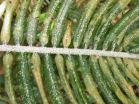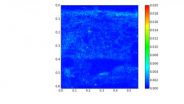(Press-News.org) Everyone needs to eat. But it's a dog-eat-dog world, and with the exception of the top predators, everyone also gets eaten. To cope with this vicious reality, a tiny insect that eats plants has learned to employ the plant's hairs for physical protection from its beetle predator.
The pest is called the cycad aulacaspis scale, and its invasion into numerous countries in recent years has caused immeasurable loss of biodiversity. Cycads belong to an ancient lineage of plants that date to the dinosaur era, and the pest requires a cycad plant for food. The insect's recent invasion to the island of Guam has endangered the island's endemic cycad species. Local biologists introduced a voracious beetle predator to the island to eat the scale insects, but the plant damage by the pest has persisted.
"We began looking into the reasons that the beetle was failing to control the pest, and discovered that the pest could crawl between the plant's trichomes to reach its feeding sites," said UOG Professor Thomas Marler. Trichomes are what biologists call the hairs that can be found on many plant leaves and stems. Unfortunately, the much larger beetle predator could not make the same journey through the trichomes to feed on the scale insects that were feeding on the plant beneath the trichomes.
Plant hairs serve several functions, and one of those functions is to protect the plant from insects. "The glitch in this situation was that the insect that was excluded by the plant hairs was our beneficial insect that eats the scale pest, and the insect that could just walk straight through the hairs was the very pest we wished to control," said Marler.
Insects that eat plants have adopted numerous strategies to avoid getting eaten. One of those strategies is to co-opt one of the tactics that plants effectively use to avoid getting eaten. For example, plants produce a plethora of chemicals that taste bad or serve as a poison to herbivores. These chemicals are effective in deterring the feeding of most general insect herbivores. A well-studied practice by some specialist insects is their predilection to consume these plant poisons, sequester those poisons into parts of their body, then exploit the poisons for their own protection.
"Here we find another example of how an herbivore insect can be confronted with a plant's behavior that helps reduce the likelihood of being eaten, then take advantage of that behavior by using it for the same purpose," said Marler. This particular plant-pest-predator relationship has drawn the attention of biologists in the Western Pacific Tropical Research Center at the University of Guam because this pest is threatening cycad populations in other countries. Lessons learned on Guam may benefit cycad conservationists in those other countries. Marler's research appears in the November issue of the journal Plant Signaling and Behavior.
INFORMATION:
On the web: http://www.landesbioscience.com/journals/psb/article/22013/
Pest uses plant hairs for protection
Trichomes save insect from beetle predation
2013-02-06
ELSE PRESS RELEASES FROM THIS DATE:
Traumatic brain injury complications common among US combat soldiers
2013-02-06
U.S. soldiers in combat often suffer constricted blood vessels and increased pressure in the brain — significant complications of traumatic brain injuries, according to research presented at the American Stroke Association's International Stroke Conference 2013.
"Research shows that traumatic brain injury is a hallmark of recent military conflicts, affecting nearly a third of all wounded soldiers," said Alexander Razumovsky, Ph.D., lead researcher and director of Sentient NeuroCare Services in Hunt Valley, Md.
Constricted blood vessels in the brain are cerebral vasospasm.
...
Smoking marijuana associated with higher stroke risk in young adults
2013-02-06
Marijuana, the most widely used illicit drug, may double stroke risk in young adults, according to research presented at the American Stroke Association's International Stroke Conference 2013.
In a New Zealand study, ischemic stroke and transient ischemic attack (TIA) patients were 2.3 times more likely to have cannabis, also known as marijuana, detected in urine tests as other age and sex matched patients, researchers said.
"This is the first case-controlled study to show a possible link to the increased risk of stroke from cannabis," said P. Alan Barber, Ph.D., M.D., ...
Native Hawaiians have bleeding strokes at earlier age, independent of meth use
2013-02-06
Native Hawaiians and Pacific Islanders have more bleeding strokes at an earlier age than other people independent of methamphetamine abuse, according to research presented at the American Stroke Association's International Stroke Conference 2013.
"Drug abuse is a huge problem here and it definitely is a cause of hemorrhagic stroke," said Kazuma Nakagawa, M.D., lead investigator and assistant professor of medicine at the University of Hawaii. "But Native Hawaiians and Pacific Islanders are experiencing this form of stroke at a younger age even without methamphetamine use. ...
Tai Chi exercise may reduce falls in adult stroke survivors
2013-02-06
Tai Chi may reduce falls among adult stroke survivors, according to research presented at the American Stroke Association's International Stroke Conference 2013.
Compared to survivors receiving usual care or participating in a national fitness program for Medicare-eligible adults called SilverSneakers®, those practicing Tai Chi had the fewest falls.
Tai Chi is a martial art dating back to ancient China. It includes physical movements, mental concentration and relaxed breathing.
"Learning how to find and maintain your balance after a stroke is a challenge," said Ruth ...
Brain research provides clues to what makes people think and behave differently
2013-02-06
Differences in the physical connections of the brain are at the root of what make people think and behave differently from one another. Researchers reporting in the February 6 issue of the Cell Press journal Neuron shed new light on the details of this phenomenon, mapping the exact brain regions where individual differences occur. Their findings reveal that individuals' brain connectivity varies more in areas that relate to integrating information than in areas for initial perception of the world.
"Understanding the normal range of individual variability in the human ...
Induction of mild inflammation leads to cognitive deficits related to schizophrenia
2013-02-06
Researchers at the Institute for Comprehensive Medical Science, Fujita Health University and the National Institute for Physiological Sciences, Japan, along with colleagues from 9 other institutions, have identified an exceptional mouse model of schizophrenia. After screening over 160 mutant mouse strains with a systematic battery of behavioral tests, they identified a mutant mouse lacking the Schnurri-2 protein (Shn-2 KO) that exhibits behavioral deficits and other brain features consistent with schizophrenia. Shn-2 is an NF-B site-binding protein that binds enhancers ...
The wings of the Seagull Nebula
2013-02-06
Running along the border between the constellations of Canis Major (The Great Dog) and Monoceros (The Unicorn) in the southern sky, the Seagull Nebula is a huge cloud mostly made of hydrogen gas. It's an example of what astronomers refer to as an HII region. Hot new stars form within these clouds and their intense ultraviolet radiation causes the surrounding gas to glow brightly.
The reddish hue in this image is a telltale sign of the presence of ionised hydrogen [1]. The Seagull Nebula, known more formally as IC 2177, is a complex object with a bird-like shape that is ...
Study points to possible cause of, and treatment for, non-familial Parkinson's
2013-02-06
New York, NY (February 6, 2013) — Columbia University Medical Center (CUMC) researchers have identified a protein trafficking defect within brain cells that may underlie common non-familial forms of Parkinson's disease. The defect is at a point of convergence for the action of at least three different genes that had been implicated in prior studies of Parkinson's disease. Whereas most molecular studies focus on mutations associated with rare familial forms of the disease, these findings relate directly to the common non-familial form of Parkinson's. The study was published ...
X-rays reveal uptake of nanoparticles by soya bean crops
2013-02-06
Scientists have, for the first time, traced the nanoparticles taken up from the soil by crop plants and analysed the chemical states of their metallic elements. Zinc was shown to dissolve and accumulate throughout the plants, whereas the element cerium did not dissolve into plant tissue. The results contribute to the controversial debate on plant toxicity of nanoparticles and whether engineered nanoparticles can enter into the food chain. The study was published on 6 February 2013 in the journal ACS Nano.
The international research team was led by Jorge Gardea-Torresdey ...
Earth-like planets are right next door
2013-02-06
Using publicly available data from NASA's Kepler space telescope, astronomers at the Harvard-Smithsonian Center for Astrophysics (CfA) have found that six percent of red dwarf stars have habitable, Earth-sized planets. Since red dwarfs are the most common stars in our galaxy, the closest Earth-like planet could be just 13 light-years away.
"We thought we would have to search vast distances to find an Earth-like planet. Now we realize another Earth is probably in our own backyard, waiting to be spotted," said Harvard astronomer and lead author Courtney Dressing (CfA).
Dressing ...
LAST 30 PRESS RELEASES:
Sports injuries sustained during your period might be more severe
World's first successful 2 Tbit/s free-space optical communication using small optical terminals mountable on satellites and HAPS
Can intimate relationships affect your heart? New study says ‘yes’
Scalable and healable gradient textiles for multi‑scenario radiative cooling via bicomponent blow spinning
Research shows informed traders never let a good climate crisis go to waste
Intelligent XGBoost framework enhances asphalt pavement skid resistance assessment
Dual-function biomaterials for postoperative osteosarcoma: Tumor suppression and bone regeneration
New framework reveals where transport emissions concentrate in Singapore
NTP-enhanced lattice oxygen activation in Ce-Co catalysts for low-temperature soot combustion
Synergistic interface engineering in Cu-Zn-Ce catalysts for efficient CO2 hydrogenation to methanol
COVID-19 leaves a lasting mark on the human brain
Scientists use ultrasound to soften and treat cancer tumors without damaging healthy tissue
Community swimming program for Black youth boosts skills, sense of belonging, study finds
Specific depressive symptoms in midlife linked to increased dementia risk
An ‘illuminating’ design sheds light on cholesterol
Who is more likely to get long COVID?
Study showcases resilience and rapid growth of “living rocks”
Naval Research Lab diver earns Office of Naval Research 2025 Sailor of the Year
New Mayo-led study establishes practical definition for rapidly progressive dementia
Fossil fuel industry’s “climate false solutions” reinforce its power and aggravate environmental injustice
Researchers reveal bias in a widely used measure of algorithm performance
Alcohol causes cancer. A study from IOCB Prague confirms damage to DNA and shows how cells defend against it
Hidden viruses in wastewater treatment may shape public health risks, study finds
Unlock the power of nature: how biomass can transform climate mitigation
Biochar reshapes hidden soil microbes that capture carbon dioxide in farmland
Reducing saturated fat intake shows mortality benefit, but only in high-risk individuals
Manta rays create mobile ecosystems, study finds
Study: Mixed results in using lipoic acid to treat progressive multiple sclerosis
Norbert Holtkamp appointed director of Fermi National Accelerator Laboratory
New agentic AI platform accelerates advanced optics design
[Press-News.org] Pest uses plant hairs for protectionTrichomes save insect from beetle predation




